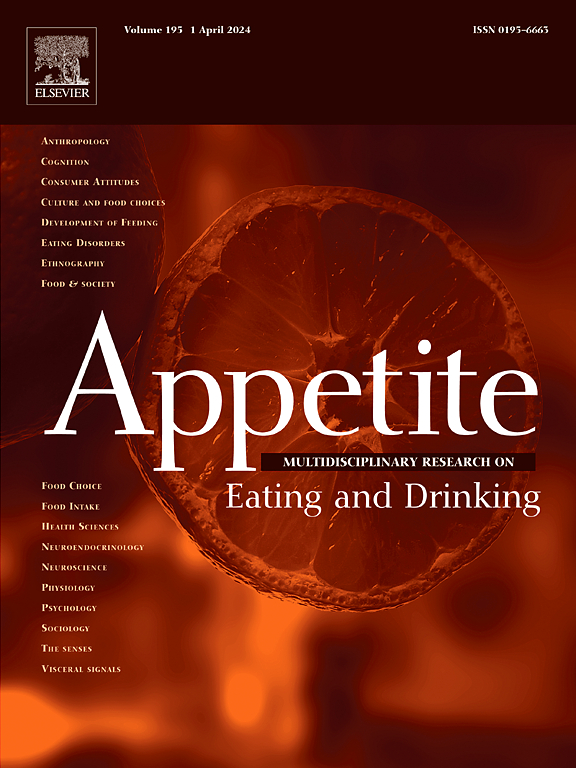上下文中的蛋白质:探索英国成年人中无肉和基于肉的饮食场合的内容和背景。
IF 3.8
2区 医学
Q1 BEHAVIORAL SCIENCES
引用次数: 0
摘要
鉴于需要减少对肉类的依赖,推进蛋白质转型需要更清楚地了解日常饮食中不同的蛋白质来源是如何嵌入的。本研究探讨了英国成年人饮食场合的内容和背景,他们被确定为杂食者或弹性食者(N = 1212),使用24小时饮食回忆数据来捕捉所消耗的食物和饮料,以及与之相关的情境、时间和社会因素。结果显示,19.1%的晚餐(晚餐)和39.5%的午餐是无肉的(这里定义为含有素食蛋白或低蛋白的无肉场合),而早餐和零食的比例为80%。不吃肉的时候,人们通常只吃较少的主食,比如土豆和蔬菜配菜。无肉素食蛋白餐更常与谷物和牛奶等习惯性早餐一起食用,而无肉低蛋白餐通常完全缺乏结构,包含随意选择的食物(如糖果和咸零食)。与肉类为主的场合相比,无肉素食蛋白的场合更多地发生在早餐,无肉低蛋白的场合更多地发生在零食中。这两种药物通常都是在家里单独服用,而且服用时间很短。这些发现表明,人们吃什么,如何吃,何时吃,和谁一起吃,都是日常蛋白质消费现实的重要因素,为支持蛋白质转变的努力提供了有价值的见解。本文章由计算机程序翻译,如有差异,请以英文原文为准。
Protein in context: Exploring the content and context of meat-free and meat-based eating occasions among UK adults
In light of the need to reduce reliance on meat, advancing a protein transition requires a clearer understanding of how different protein sources are embedded in everyday eating. This study explored both the content and context of eating occasions among UK adults who identified as omnivores or flexitarians (N = 1,212). 24-h dietary recall data was used to capture both the foods and beverages consumed, along with their associated situational, temporal, and social factors. Results showed that 19.1 % of dinners (i.e., evening meals) and 39.5 % of lunches were meat-free (defined here as meatless occasions containing either vegetarian protein or low protein), compared to >80 % for breakfast and snacks. Meat-free occasions were generally consumed with fewer components that typically lend compositional structure to main meals—such as potatoes and vegetable sides. Meat-free vegetarian protein occasions were more often consumed with habitual breakfast items like cereal and milk, while meat-free low protein eating occasions often lacked structure altogether and contained discretionary (e.g., sweets and salted snack) foods. Compared to meat-based occasions, meat-free vegetarian protein occasions more frequently occurred at breakfast, and meat-free low protein occasions more frequently occurred as snacks. Both were commonly consumed at home, alone, and in short durations. These findings reveal that what people eat, as well as how, when, and with whom they eat it, are all important elements of the everyday realities of protein consumption—offering valuable insights for efforts to support the protein transition.
求助全文
通过发布文献求助,成功后即可免费获取论文全文。
去求助
来源期刊

Appetite
医学-行为科学
CiteScore
9.10
自引率
11.10%
发文量
566
审稿时长
13.4 weeks
期刊介绍:
Appetite is an international research journal specializing in cultural, social, psychological, sensory and physiological influences on the selection and intake of foods and drinks. It covers normal and disordered eating and drinking and welcomes studies of both human and non-human animal behaviour toward food. Appetite publishes research reports, reviews and commentaries. Thematic special issues appear regularly. From time to time the journal carries abstracts from professional meetings. Submissions to Appetite are expected to be based primarily on observations directly related to the selection and intake of foods and drinks; papers that are primarily focused on topics such as nutrition or obesity will not be considered unless they specifically make a novel scientific contribution to the understanding of appetite in line with the journal's aims and scope.
 求助内容:
求助内容: 应助结果提醒方式:
应助结果提醒方式:


